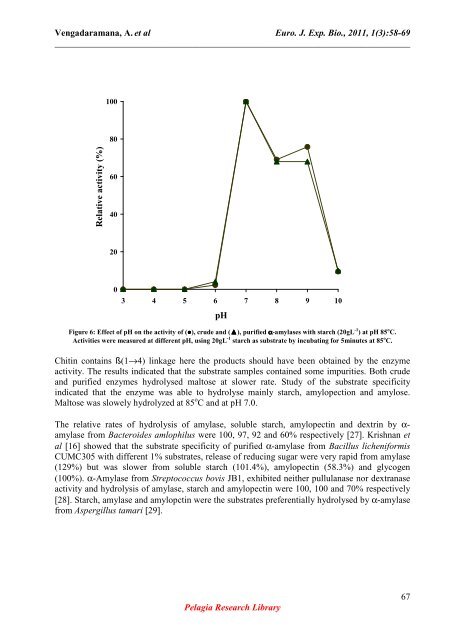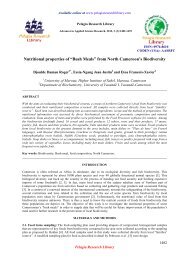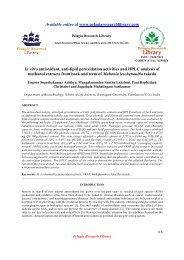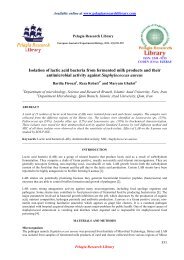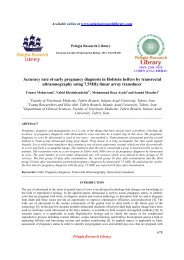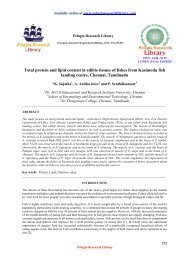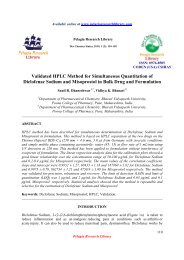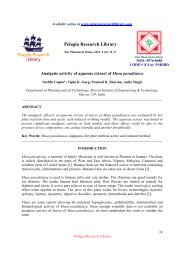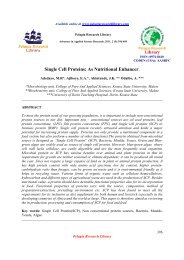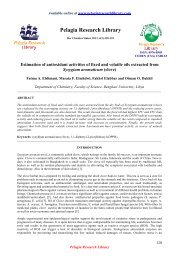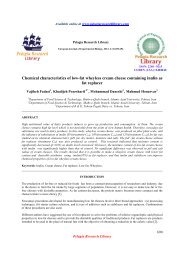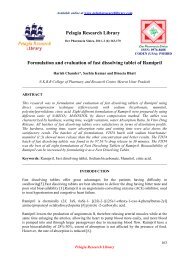Purification and comparison properties of crude enzyme with ...
Purification and comparison properties of crude enzyme with ...
Purification and comparison properties of crude enzyme with ...
You also want an ePaper? Increase the reach of your titles
YUMPU automatically turns print PDFs into web optimized ePapers that Google loves.
Vengadaramana, A. et al Euro. J. Exp. Bio., 2011, 1(3):58-69<br />
______________________________________________________________________________<br />
Relative activity (%)<br />
100<br />
80<br />
60<br />
40<br />
20<br />
0<br />
3 4 5 6 7 8 9 10<br />
pH<br />
Figure 6: Effect <strong>of</strong> pH on the activity <strong>of</strong> (●), <strong>crude</strong> <strong>and</strong> (▲), purified α-amylases <strong>with</strong> starch (20gL -1 ) at pH 85 o C.<br />
Activities were measured at different pH, using 20gL -1 starch as substrate by incubating for 5minutes at 85 o C.<br />
Chitin contains ß(1→4) linkage here the products should have been obtained by the <strong>enzyme</strong><br />
activity. The results indicated that the substrate samples contained some impurities. Both <strong>crude</strong><br />
<strong>and</strong> purified <strong>enzyme</strong>s hydrolysed maltose at slower rate. Study <strong>of</strong> the substrate specificity<br />
indicated that the <strong>enzyme</strong> was able to hydrolyse mainly starch, amylopection <strong>and</strong> amylose.<br />
Maltose was slowely hydrolyzed at 85 o C <strong>and</strong> at pH 7.0.<br />
The relative rates <strong>of</strong> hydrolysis <strong>of</strong> amylase, soluble starch, amylopectin <strong>and</strong> dextrin by αamylase<br />
from Bacteroides amlophilus were 100, 97, 92 <strong>and</strong> 60% respectively [27]. Krishnan et<br />
al [16] showed that the substrate specificity <strong>of</strong> purified α-amylase from Bacillus licheniformis<br />
CUMC305 <strong>with</strong> different 1% substrates, release <strong>of</strong> reducing sugar were very rapid from amylase<br />
(129%) but was slower from soluble starch (101.4%), amylopectin (58.3%) <strong>and</strong> glycogen<br />
(100%). α-Amylase from Streptococcus bovis JB1, exhibited neither pullulanase nor dextranase<br />
activity <strong>and</strong> hydrolysis <strong>of</strong> amylase, starch <strong>and</strong> amylopectin were 100, 100 <strong>and</strong> 70% respectively<br />
[28]. Starch, amylase <strong>and</strong> amylopctin were the substrates preferentially hydrolysed by α-amylase<br />
from Aspergillus tamari [29].<br />
Pelagia Research Library<br />
67


